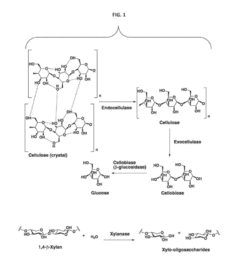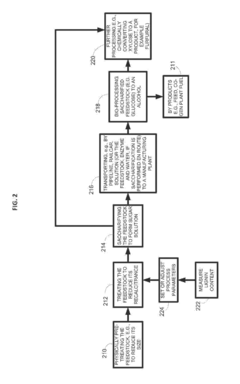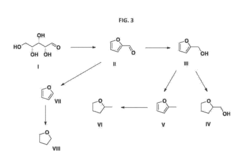Research on molecular architecture modification for improving material properties - Eureka
OCT 8, 20243 MIN READ
Generate Your Technical Report in Patsnap Eureka
AI-Powered Innovation Solution Platform for R&D
Molecular Architecture Modification Goals
The primary objective is to explore the potential of molecular architecture modification as a strategy for enhancing material properties. This involves investigating various approaches to alter the molecular structure and arrangement within materials, with the aim of achieving desired improvements in characteristics such as mechanical strength, thermal stability, electrical conductivity, or optical properties.
Key areas of focus include developing novel synthetic methods, incorporating functional groups or nanostructures, and engineering molecular interactions and self-assembly processes. The research aims to uncover innovative pathways for tailoring material performance through precise control over molecular-level architecture.
Key areas of focus include developing novel synthetic methods, incorporating functional groups or nanostructures, and engineering molecular interactions and self-assembly processes. The research aims to uncover innovative pathways for tailoring material performance through precise control over molecular-level architecture.
Market Demand for Enhanced Material Properties
- Growing Demand for Advanced Materials
The market is witnessing a surge in demand for materials with enhanced properties, driven by the need for improved performance, durability, and sustainability across various industries. - Diverse Application Areas
Enhanced material properties find applications in sectors such as aerospace, automotive, construction, electronics, and renewable energy, enabling the development of lighter, stronger, and more efficient products. - Performance and Efficiency Gains
Materials with improved properties offer significant performance and efficiency gains, leading to reduced energy consumption, extended product lifetimes, and lower maintenance costs. - Environmental and Sustainability Considerations
The demand for environmentally friendly and sustainable materials is increasing, driving the need for materials with improved properties that can reduce environmental impact and support circular economy initiatives. - Emerging Technologies and Innovations
Advancements in fields like nanotechnology, additive manufacturing, and biomimetics are fueling the development of materials with unprecedented properties, creating new market opportunities.
Current State and Challenges in Material Modification
- Material Modification Challenges
- Controlling molecular architecture with precision
- Achieving desired properties without compromising others
- Scalability and cost-effectiveness of modification processes
- Technical Bottlenecks
- Limited understanding of structure-property relationships
- Lack of advanced characterization techniques
- Difficulties in controlling reactions at molecular level
- Geographical Distribution
- Major research hubs in USA, Europe, and Asia
- Collaborative efforts across academia and industry
- Emerging contributions from developing nations
Evolution of Molecular Architecture Techniques

Existing Solutions for Material Property Enhancement
01 Light Resistance and Stability Enhancement
Techniques involving incorporating specific additives or modifying molecular structure to improve resistance to light degradation and maintain properties over time.- Light Resistance and Stability Improvement: Compositions and methods for enhancing light resistance and stability of high molecular materials by incorporating additives or modifying molecular structure to improve resistance to light-induced degradation.
- Thermal and Electrical Property Enhancement: Approaches for improving thermal conductivity, electrical conductivity, and related properties of high molecular materials, involving conductive filler incorporation, molecular structure modification, or specialized processing techniques.
- Mechanical Property Improvement: Techniques for enhancing mechanical properties like strength, toughness, and wear resistance of high molecular materials through molecular structure modification, reinforcing filler incorporation, or specialized processing.
- Molecular Property Prediction and Modeling: Methods and systems for predicting and modeling properties of molecular compounds and materials based on molecular structure, using computational simulations, machine learning algorithms, or data-driven approaches.
- Functional Property Enhancement: Techniques for improving functional properties like optical, electronic, or catalytic properties of high molecular materials through molecular structure modification, functional additive incorporation, or specialized processing.
02 Molecular Material Characterization and Analysis
Methods and devices for analyzing properties of molecular materials, including molecular simulations, homogenization analysis, and prediction models for physical, chemical, or structural properties.03 Mechanical and Functional Property Improvement
Techniques for enhancing mechanical and functional properties, such as wear resistance, heat conduction, and processability, through molecular structure modification, additive incorporation, or specialized processing.04 Improved Property Material Preparation
Methods for preparing high molecular materials with enhanced properties, like biogas production, chirality, or specific optical/electrical characteristics, via molecular structure modification, functional group incorporation, or specialized synthesis.05 Absorbent and Surface Property Enhancement
Techniques for improving absorbent and surface properties, such as absorbency, wettability, or surface energy, through structure modification, additive incorporation, or surface treatments.
Key Players in Material Science and Engineering
The competitive landscape for research on molecular architecture modification for improving material properties involves established corporations and academic institutions. Key players include Xyleco, Inc., China Petroleum & Chemical Corp., General Electric Company, BASF Plant Science LLC, and IBM Corp., indicating significant industry interest and investment. The market is growing, driven by advancements in nanotechnology and materials science.
China Petroleum & Chemical Corp.
Technical Solution: China Petroleum & Chemical Corp. develops techniques to enhance polymer properties through catalysts and specific reaction conditions, resulting in improved mechanical strength, thermal stability, and chemical resistance.
Strength: High expertise in chemical processes. Weakness: Limited application to non-polymer materials.
General Electric Company
Technical Solution: General Electric Company focuses on molecular architecture modification for high-performance aerospace and energy materials, using computational modeling and experimental techniques to design and synthesize materials with superior properties like high-temperature resistance and enhanced durability.
Strength: Strong R&D capabilities. Weakness: High cost of implementation.
Core Innovations in Molecular Architecture
Conversion of Biomass
PatentActiveUS20170066736A1
Innovation
- The use of xylose as a feedstock for converting into furfural and its derivatives. this expands the range of available feedstocks for bioconversion processes.
- The ability to chemically convert xylose to furfural and its derivatives by various methods, including cyclization reactions, polymerization reactions, condensation reactions, reduction reactions, and esterification reactions. this allows for the production of a wide variety of furfural-derived products.
- The option to further convert the furfural and its derivatives through various processes, such as hydrogenation to produce furfuryl alcohol, or by polymerization to create poly(furfuryl alcohol) or polyethers. this provides flexibility in the production of different derivatives from the same feedstock.
Regulatory Landscape for Material Modifications
Molecular architecture modification aims to enhance material properties by altering the molecular structure and composition. This technology has gained significant traction due to the growing demand for advanced materials with tailored properties. The market potential spans various industries, including electronics, energy, and biomedical sectors. Key challenges involve precise control over molecular assembly, scalability, and cost-effectiveness. Potential innovation directions include self-assembly techniques, computational modeling, and integration with emerging fabrication methods like 3D printing. Leading players are actively investing in R&D, with major contributions from academic institutions and research consortia. Comprehensive analysis and strategic recommendations are crucial for leveraging this technology's potential and driving material innovation.
the structure of the environmentally friendly knitted fabric provided by the present invention; figure 2 Flow chart of the yarn wrapping machine for environmentally friendly knitted fabrics and storage devices; image 3 Is the parameter map of the yarn covering machine
Login to View More Environmental Impact of Material Modifications
Molecular architecture modification aims to enhance material properties by altering the molecular structure and composition. This technology has gained significant traction due to the growing demand for advanced materials with tailored properties. The market potential spans various industries, including electronics, energy, and biomedical sectors. Key challenges involve precise control over molecular assembly, scalability, and cost-effectiveness. Potential innovation directions include self-assembly techniques, computational modeling, and integration with emerging fabrication methods like 3D printing. Leading players in this field include research institutions, material science companies, and technology giants exploring novel applications.
the structure of the environmentally friendly knitted fabric provided by the present invention; figure 2 Flow chart of the yarn wrapping machine for environmentally friendly knitted fabrics and storage devices; image 3 Is the parameter map of the yarn covering machine
Login to View More If you want an in-depth research or a technical report, you can always get what you want in Patsnap Eureka TechResearch . Try now!



